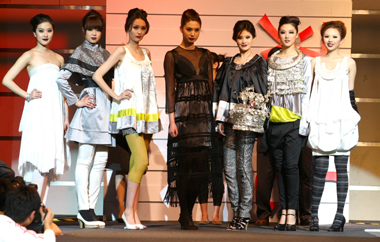 |
|
Yeakee Shi's Best Design Award-winning collection, "Miao Element," featuring pieces inspired by traditional attire of China's Miao minority. |
It's always interesting to attend a fashion show by students. It lasts a good 30 minutes and you never know what will show up from minute to minute, be it a copy of John Galliano or a really bold, nonsense costume.
The annual graduation show of the Raffles Design Institute Shanghai last Friday did not disappoint. The venue at Pudong's Super Brand Mall was packed with enthusiastic fashion students, their parents, and of course, industry insiders and the press.
"Contrast" was the theme. To students, "contrast" means much more than the difference between black and white.
For example, in terms of volume, there were cocktail dresses featuring tight qipao-style tops and voluminous balloon skirts, boyfriend jackets to be worn with glittering tights. A pair of summer shorts was matched with a heavy winter coat.
In terms of fabric, silk was combined with wool, fur with chiffon.
Tops and pants of asymmetrical cuttings and intriguing prints prevailed on the catwalk.
The Best Design Award went to Yeakee Shi, whose "Miao Element" collection features eight pieces inspired by traditional attire of China's Miao minority.
"My collection is a contrast between old and new," she explains. "All the pieces are created for modern peoples' wardrobes, with handmade details and A-line silhouettes revealing their links with traditional Miao costumes."
Surprisingly, Shi has never been to Yunnan Province, or met the Miao people.
The 24-year-old spent four months researching Miao culture and another two months designing and making the clothes, all by herself.
She made an all-white pleated cocktail dress inspired by the pleating details on traditional Miao clothing. She found large, Miao-style silver headgear and necklaces from local markets to accessorize her designs.
Shi created a one-of-a-kind print featuring tangled strings, evocative of Miao women's intricate hairstyles. The print is used on several tops.
The show also featured dramatic pieces like weird skirts made from hard metals (think the "circus dress" Katy Perry wore to the MTV Awards).
At the same time, there were also stylish, wearable outfits such as a gray suit with decorated shoulders and asymmetrically cut coats decorated with fake-fur tassels.
At the show booths were set up next to the runway to showcase students' works from each department, as well as products from sponsors, including hair care to jewelry, catering services to education.
The smell of money, or rather, the accent of commerce, was in the air.
Nowadays, more and more fashion students have come to realize the importance of marketing and merchandising their designs.
Donghua University is helping to promote students' works to the public. Most recently the university that specializes in textile and fashion design has collaborated with Highstreet Loft, a creative zone in Xuhui District, to launch Donghua Zero Space.
The store on the fourth floor of the main shopping mall in the area serves as a showroom where visitors can spot fresh ideas by students in fashion design, industrial design and environmental art design.
"Most of the clothes on display are actually students' home works," says Ma Ni, vice general manager of Shanghai Highstreet Loft Investment Co. "We want to create a platform for these promising designers of tomorrow so that their works are no longer restricted in the classrooms."
These clothes might not be made from high-quality fabrics but they are 100-percent original and one-of-a-kind.
There's a very ethnic feel to accessories including bags, hats, scarves and gloves.
The display changes every two months.
Students are also encouraged to take part in the visual merchandising procedure, and even manage the store for a while.
"Students can learn much more about the real market from a store like this than they can learn from textbooks," Ma says.
Fashion companies are encouraged to visit the space spot talents.
(Shanghai Daily April 2, 2009)